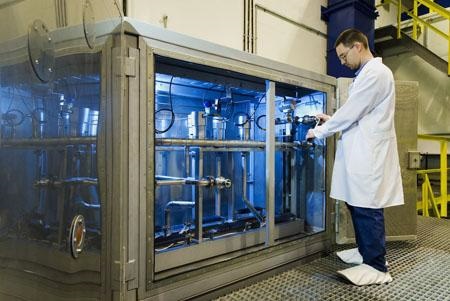Brazil's Angra plant to get domestic fuel
06 November 2014
Industrias Nucleares do Brasil (INB) will provide enriched uranium for the first time for unit 1 of the country's sole nuclear power plant.
 |
| A module of INB's enrichment facility (Image: INB) |
INB said yesterday that its uranium enrichment plant at Resende will provide UF6 for the Angra reactor's twenty-second refueling that is to be completed by June 2015. Previously, the Resende plant was entirely engaged with foreign companies.
It has the capacity to meet 80% of the Angra plant's enriched fuel needs, but there are plans to expand this to 100%. This means the country will itself cater for a stage in the nuclear fuel cycle that equates to about 30% of the cost of nuclear fuel, INB said.
INB manager Janine Gandolpho da Rocha said Brazil's own production of enriched uranium will thus bring its nuclear power industry "big savings".
The Resende plant will increase the uranium-235 content of uranium from naturally occurring 0.72% to around 4%, INB said. Unlike the predominant isotope uranium-238, U235 is fissile, meaning it can sustain a fissile chain reaction.
In early 2010, INB signed a five-year conversion services contract with Areva of France. Under the contract, Areva is responsible for converting 2520 tonnes of uranium concentrate over the five-year period. INB said then that the contract was awarded following an international tender and will help it to supply fuel to the existing Angra units 1 and 2, as well as the third unit of the plant, due to begin commercial operation in 2015.
Uranium used to fuel Brazil's nuclear power reactors has previously been sent as uranium concentrate to Cameco in Canada to be converted into uranium hexafluoride (UF6) gas, which was then sent to Urenco's enrichment plants in Europe. After enrichment, the gas was returned to Brazil for INB to reconvert the UF6 gas to powder, which is then used to produce nuclear fuel pellets.
However, INB has begun operating a uranium enrichment plant at Resende. Stage 1 - eventually to be four modules totalling 115,000 SWU per year and costing $170 million - was officially opened in 2006. Each module consists of four or five cascades of 5000-6000 SWU per year. Early in 2009, it was announced that INB would begin full operation of the Resende plant in May 2009. The full stage 1 plant was expected to produce 60% of the fuel needs for Angra units 1 and 2 by 2012. Stage 2 will take capacity to 200,000 SWU. The centrifuges are domestically-developed and very similar to Urenco technology.
INB's fuel fabrication plant, designed by Siemens, is also at Resende, with capacity of 160 tonnes per year pellet production and 280 tonnes per year fuel assembly production.
Researched and written
by World Nuclear News